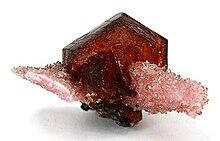|
Shigaite
Shigaite is a mineral with formula NaAl3(Mn2+)6(SO4)2(OH)18·12H2O that typically occurs as small, hexagonal crystals or thin coatings. It is named for Shiga Prefecture, Japan, where it was discovered in 1985.[3] The formula was significantly revised in 1996, identifying sodium as a previously unknown constituent. Description Shigaite occurs as hexagonal tabular crystals up to 2 cm (0.79 in) in size or as thin films and coatings. The mineral can be yellow, burnt orange, brown or black in color.[5] Shigaite occurs in metamorphosed deposits of manganese ore[5] and is the Mn2+ analogue of motukoreaite.[6] StructureShigaite consists of oxycation sheets of [AlMn2+2(OH)6]1+ intercalated with oxyanion sheets of [Na(H2O)6{H2O}6(SO4)2]3−. Linkage between the sheets and within the oxyanion sheet results largely through hydrogen bonding.[6] HistoryShigaite was discovered in 1985 in the Ioi Mine,[a] Shiga Prefecture, Japan.[3] The original study, published in the journal Neues Jahrbuch für Mineralogie, Monatshefte,[1] identified the formula as Al4Mn7(SO4)2(OH)22·8H2O.[7] The formula was significantly revised in 1996 using a sample from the N'Chwaning Mine, South Africa.[6] Sodium, discovered to be a component of shigaite, was not identified in the original study. However, an unidentified volatile had been noted that presumably was a sodium-containing complex.[8] DistributionAs of 2012[update], shigaite is known from the following sites:[3]
The type material is housed in the National Museum of Natural History in Washington, D.C. as sample 122089.[5] AssociationShigaite has been found associated with the following minerals:[5]
NotesReferencesWikimedia Commons has media related to Shigaite.
Bibliography
Further reading
|
|||||||||||||||||||||||||||||||||||||||||||||||||||||||
